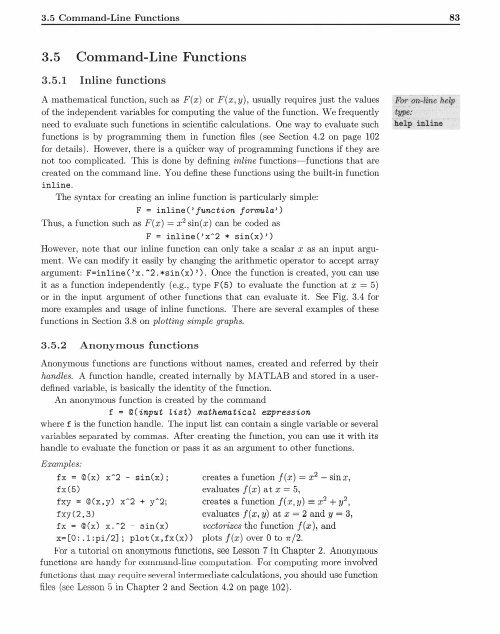You also want an ePaper? Increase the reach of your titles
YUMPU automatically turns print PDFs into web optimized ePapers that Google loves.
3.5 Command-Line Functions<br />
83<br />
3.5 Command-Line Functions<br />
3.5.1 Inline functions<br />
A mathematical function, such as F(x) or F(x, y), usually requires just the values<br />
of the independent variables for computing the value of the function. We frequently<br />
need to evaluate such functions in scientific calculations. One way to evaluate such<br />
functions is <strong>by</strong> programming them in function files (see Section 4.2 on page 102<br />
for details). However, there is a quicker way of programming functions if they are<br />
not too complicated. This is done <strong>by</strong> defining inline functions-functions that are<br />
created on the command line. You define these functions using the built-in function<br />
inline.<br />
The syntax for creating an inline function is particularly simple:<br />
F = inline ('function formuLa')<br />
Thus, a function such as F(x) = x 2 sin(x) can be coded as<br />
F = inline ('x-2 * sin(x) ')<br />
However, note that our inline function can only take a scalar x as an input argument.<br />
We can modify it easily <strong>by</strong> changing the arithmetic operator to accept array<br />
argument: F=inline ( 'x. -2. *sin (x) ' ) . Once the function is created, you can use<br />
it as a function independently (e.g., type F(5) to evaluate the function at x = 5)<br />
or in the input argument of other functions that can evaluate it. See Fig. 3.4 for<br />
more examples and usage of inline functions. There are several examples of these<br />
functions in Section 3.8 on plotting simple graphs.<br />
'"F'o r a.n:ti rie 'help·<br />
type:<br />
b._;3 p inline<br />
3.5.2 Anonymous functions<br />
Anonymous functions are functions without names, created and referred <strong>by</strong> their<br />
handles. A function handle, created internally <strong>by</strong> <strong>MATLAB</strong> and stored in a userdefined<br />
variable, is basically the identity of the function.<br />
An anonymous function is created <strong>by</strong> the command<br />
f = ©(input List) mathematicaL expression<br />
where f is the function handle. The input list can contain a single variable or several<br />
variables separated <strong>by</strong> commas. After creating the function, you can use it with its<br />
handle to evaluate the function or pass it as an argument to other functions.<br />
Examples:<br />
fx = ©(x) x-2 - sin(x) ;<br />
fx(5)<br />
fxy = ©(x,y) x-2 + y-2;<br />
fxy(2,3)<br />
fx - @(x) x.- 2 - 5in (x)<br />
x= [O: .i:pi/2] ; plot (x,fx (x))<br />
creates a function f ( x) = x 2 - sin x,<br />
evaluates f(x) at x = 5,<br />
creates a function f(x, y) = x 2 + y 2 ,<br />
evaluates f(x, y) at x = 2 and y= 3,<br />
vcctorizcs the function .f ( x), and<br />
plots f(x) over 0 to n/2.<br />
For a tutorial on anonymous functions, see Lesson 7 in Chapter 2. Anonymous<br />
functions are handy for comm:.md-line computation. For computing more involved<br />
functions that may require several intermediate calculations, you should usc function<br />
files (see Lesson 5 in Chapter 2 and Section 4.2 on page 102).



